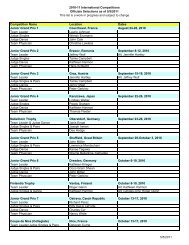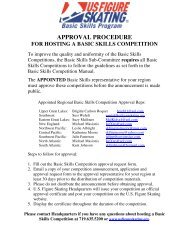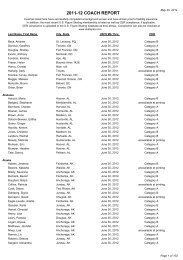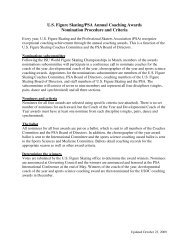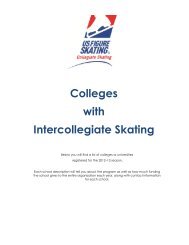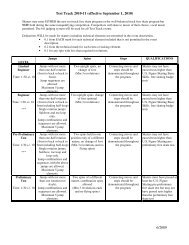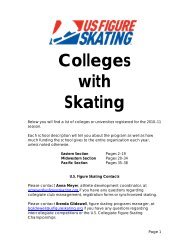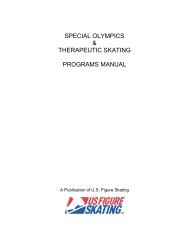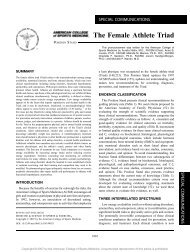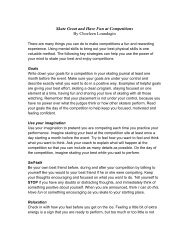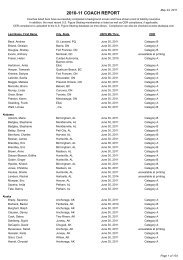2012-13 ISU Handbook for Referees and Judges - US Figure Skating
2012-13 ISU Handbook for Referees and Judges - US Figure Skating
2012-13 ISU Handbook for Referees and Judges - US Figure Skating
You also want an ePaper? Increase the reach of your titles
YUMPU automatically turns print PDFs into web optimized ePapers that Google loves.
Judging System<strong>H<strong>and</strong>book</strong><strong>for</strong> <strong>Referees</strong> <strong>and</strong><strong>Judges</strong>Ice DanceAs of 31.7.<strong>2012</strong>
SummaryGeneral requirements <strong>for</strong> Short Dance 3Required Elements <strong>for</strong> Short Dance 6General requirements <strong>for</strong> Free Dance 7Well Balanced Free Dance Program 9Specifications to common Short Dance <strong>and</strong> Free Dance Required Elements 10Marking guide <strong>for</strong> Grade of Execution of Required Elements 11Definitions 11Characteristics of Grade of Execution 12Adjustments to Grade of Execution 15Marking guide <strong>for</strong> Program Components 16Definitions 16Characteristics of Program Components 19Adjustments to Program Components in Short Dance 24Adjustments to Program Components in Free Dance 25Clothing 26Deductions – who is responsible 27Drawings 28Description, chart <strong>and</strong> diagram of Blues 28Description, chart <strong>and</strong> diagram of Yankee Polka 30Questions <strong>and</strong> answers 33Music 33Required Elements 35Costume <strong>and</strong> props 37Various 38
Category: Ice DanceSubject: General requirements <strong>for</strong> Short DanceDefinition <strong>and</strong>alterations adoptedby IDTC <strong>for</strong> season<strong>2012</strong>/<strong>13</strong> accordingto Rule 609, § 1.h)(alterations areunderlined)a) “Short Dance” - is a dance created by an Ice Dance couple to dance music with designated rhythm(s)<strong>and</strong>/or theme(s) selected by the Ice Dance Technical Committee annually <strong>for</strong> the season. The dancemust:i) reflect the character of the selected dance rhythm(s) or theme(s),ii) be translated to the ice by demonstrating technical skill with steps <strong>and</strong> movements along with flow<strong>and</strong> the use of edges,iii) fit to the phrasing of the music.Couples must skate primarily to the rhythmic beat. The dance will contain elements selected by theIce Dance Technical Committee from the list of required elements specified in paragraph 2 below.The rhythm (or group of rhythms) <strong>and</strong>/or theme(s) as well as the guidelines <strong>and</strong> technicalrequirements <strong>for</strong> the Junior <strong>and</strong> Senior programs, including specified elements will be decidedannually by the Ice Dance Technical Committee <strong>and</strong> published in an <strong>ISU</strong> Communication.b) The duration of the Short Dance is indicated in Rule 614.c) The music <strong>for</strong> the Short Dance, including music <strong>for</strong> the specified Pattern Dance (if required) is to beprovided by the Couple. Vocal music is permitted. The music must have the following characteristics:i) Only dance music with an audible rhythmic beat may be used. The music may be without anaudible rhythmic beat <strong>for</strong> up to 10 seconds at the beginning of the program.ii) The music must be selected in accordance with the designated rhythm(s) <strong>and</strong>/or theme(s).iii) The music must be selected in accordance with the specified tempo, when applicable.Short Dance music that does not adhere to these specifications will be penalized by deduction(s)(see Rule 353, paragraph 1.n) (ii)).The Couple is required to submit the name/title of the selected music <strong>and</strong> the rhythm(s)/theme(s) oftheir program when registering their music <strong>for</strong> the in<strong>for</strong>mation of the Referee <strong>and</strong> <strong>Judges</strong>;d) The pattern must proceed in a generally constant direction <strong>and</strong> must not cross the Long Axis of theice surface except once at each end of the rink (within no more than 20 meters of the barrier). Loopsin either direction are permitted provided that they do not cross the Long Axis (unless specified by theIce Dance Technical Committee <strong>and</strong> announced in an <strong>ISU</strong> Communication).e) All dance steps, turns, rotations <strong>and</strong> changes of position are permitted provided that they areappropriate to the designated rhythm(s) <strong>and</strong> the music chosen. Repetition of any steps, turns <strong>and</strong>SourceRule 609, § 1Communication1721File name: <strong>H<strong>and</strong>book</strong> <strong>for</strong> <strong>Referees</strong> <strong>and</strong> <strong>Judges</strong> <strong>2012</strong> final Page 3 of 39Version: <strong>2012</strong> v1Date: 31.7.12D – General requirements <strong>for</strong> Short Dance
Category: Ice DanceSubject: General requirements <strong>for</strong> Short Dancemovements is permitted. Difficult, original, varied <strong>and</strong> intricate footwork is required <strong>for</strong> both partners;f) There are no restrictions on Dance Holds (or variation thereof). <strong>Skating</strong> in H<strong>and</strong>-in-H<strong>and</strong> Hold withfully extended arms is permitted only if in the character of the rhythm chosen, but must not be usedexcessively;g) Partners must not separate except to change hold or to per<strong>for</strong>m required Not Touching StepSequences, required Sets of Twizzles <strong>and</strong> Turns as transitional elements or during the permittedstops. The change of hold must not exceed the duration of one measure of music.Separations at the beginning <strong>and</strong>/or end of the program may be up to 10 seconds in duration withoutrestrictions on the distance of the separation;h) After the clock is started with the first movement, the Couple must not remain in one place <strong>for</strong> morethan 10 seconds. During the program, either up to two full stops (duration must not exceed 5 secondseach) or up to one full stop (duration must not exceed 10 seconds) are permitted. Any choreographyappropriate to the music selection (including a separation of no more than two arms length apart)may be included.i) The program must be developed through skating skill <strong>and</strong> quality rather than through non-skatingactions such as sliding on one knee, or use of toe steps which should be used only to reflect thecharacter of the dance <strong>and</strong> underlining rhythm <strong>and</strong> nuances of the chosen music. In the interest ofthe public in the arena, programs should be choreographed to all sides of the arena <strong>and</strong> not onlyfocused to Judge’s side;j) Touching the ice with the h<strong>and</strong>(s) is not permitted.k) Kneeling or sliding on two knees, or sitting on the ice is not allowed <strong>and</strong> it will be considered by theTechnical Panel as a Fall.File name: <strong>H<strong>and</strong>book</strong> <strong>for</strong> <strong>Referees</strong> <strong>and</strong> <strong>Judges</strong> <strong>2012</strong> final Page 4 of 39Version: <strong>2012</strong> v1Date: 31.7.12D – General requirements <strong>for</strong> Short Dance
Category: Ice DanceSubject: General requirements <strong>for</strong> Short DanceRhythms selectedby IDTC <strong>for</strong> season<strong>2012</strong>/<strong>13</strong>Guidelines adoptedby IDTC <strong>for</strong> season<strong>2012</strong>/<strong>13</strong>SeniorOne to three of the following Rhythms: Polka,March, Waltz.The Pattern Dance Elements must be skated onthe Polka Rhythm, in any style of Polka. The tempoof the music throughout the Pattern DanceElements must be constant <strong>and</strong> in accordance withthe required tempo of the Pattern Dance YankeePolka, i.e. 60 measures of two beats or 120 beatsper minute, plus or minus 2 beats per minute.JuniorBluesorBlues plus one of the following Rhythms: Swing,Hip Hop.The Pattern Dance Elements must be skated onthe Blues Rhythm, in any style of Blues. The tempoof music throughout the Pattern Dance Elementsmust be constant <strong>and</strong> in accordance with therequired tempo of the Pattern Dance Blues, i.e. 22measures of 4 beats or 88 beats per minute, plusor minus 2 beats per minute.Polka, March, Waltz, Blues <strong>and</strong> Swing are described in the <strong>ISU</strong> Ice Dance Music Rhythms Booklet1995, pages <strong>13</strong> to 20 (Note: the description of Swing covers several different Rhythms, which areacceptable). Hip Hop is described in the Additions to the <strong>ISU</strong> Ice Dance Rhythms Booklet 1995 (see <strong>ISU</strong>Website).The concept <strong>and</strong> choreography must produce the feeling of a unified dance. The Pattern DanceElements may be skated anywhere in the Short Dance <strong>and</strong> should be integrated into the composition ofthe dance so that there should not be the feeling that there are just rhythms put together without thoughtof how they fit together.Communication1721Communication1721Duration 2 minutes <strong>and</strong> 50 seconds plus or minus 10 seconds Rule 614, § 2File name: <strong>H<strong>and</strong>book</strong> <strong>for</strong> <strong>Referees</strong> <strong>and</strong> <strong>Judges</strong> <strong>2012</strong> final Page 5 of 39Version: <strong>2012</strong> v1Date: 31.7.12D – General requirements <strong>for</strong> Short Dance
Category: Ice DanceSubject: Required Elements <strong>for</strong> Short DanceDefinitionThe list of Required Elements to be included into composition of the Short Dance <strong>and</strong> specific requirements <strong>for</strong> theseelements will be announced in an <strong>ISU</strong> Communication annually.Season <strong>2012</strong>/<strong>13</strong>Pattern Dance ElementsDance LiftStep SequencesSet of Sequential Twizzles One (1)NoteSenior(Communication 1721)Two (2) Sections of Yankee Polka: Section 1: Steps # 1-25 Section 2: Steps # 26-52,skated one after the other, with Section 1 followed bySection 2, <strong>and</strong> with Step # 1 skated on the <strong>Judges</strong> side.Junior(Communication 1721)SourceRule 609, § 2Two (2) Sequences of Blues, skated one after the otheror separately. Step #1 of each Pattern Dance Sequencemust be skated on a different side of the ice surface.Specifications: The description, chart <strong>and</strong> diagrams of the Pattern Dances are included in the <strong>ISU</strong> <strong>H<strong>and</strong>book</strong> Ice Dance 2003.Not more than one (1) Short LiftOne (1) Not Touching Midline or Circular Step SequenceThe Dance Spin is not a Required Element. Nevertheless, a spinning movement skated by the couple together inany hold around common axis on one foot (or two feet) with any number of rotations is permitted. A couple maychoose to use this movement as part of their choreography. The Technical Panel will ignore these movements <strong>and</strong>the <strong>Judges</strong> will not consider these movements as one of the permitted stops.File name: <strong>H<strong>and</strong>book</strong> <strong>for</strong> <strong>Referees</strong> <strong>and</strong> <strong>Judges</strong> <strong>2012</strong> final Page 6 of 39Version: <strong>2012</strong> v1Date: 31.7.12D – Required Elements <strong>for</strong> Short Dance
Category: Ice DanceSubject: General requirements <strong>for</strong> Free DanceDefinitiona) Free Dance is the skating by the Couple of a creative dance program blending with dance steps <strong>and</strong>movements expressing the character/rhythms(s) of the dance music chosen by the Couple.The Free Dance must contain combinations of new or known dance steps <strong>and</strong> movements includingRequired Elements composed into a well balanced, whole unit displaying excellent skating technique<strong>and</strong> the personal creativity of the Couple in concept, arrangement, <strong>and</strong> expression. The programincluding Required Elements must be skated in time <strong>and</strong> phase with the music. The Couple shouldskate primarily in time to the rhythmic beat, <strong>and</strong> not to the melody alone. The choreography shouldclearly reflect the dance character, accents <strong>and</strong> nuances of the chosen dance music, demonstratinga close relationship between partners with obvious, distinct changes of mood <strong>and</strong> pace withvariations in speed <strong>and</strong> tempo. The program must utilize the whole ice surface. The Free Dance mustnot have the concept of a Pair or show program.b) The duration of the Free Dance is indicated in Rule 614.c) The music <strong>for</strong> Free Dance may be vocal <strong>and</strong> must be suitable <strong>for</strong> Ice Dance as a sport discipline <strong>and</strong>must have the following characteristics:i) The music must have an audible rhythmic beat <strong>and</strong> melody, or audible rhythmic beat alone, butnot melody alone, <strong>and</strong> may be vocal. The music may be without an audible rhythmic beat <strong>for</strong> upto 10 seconds at the beginning or end of the program <strong>and</strong> up to 10 seconds during the program.ii) The music must have at least one change of tempo <strong>and</strong> expression. This change may be gradualor immediate, but in either case it must be obvious.iii) All music including classical music must be cut/edited, orchestrated or arranged in a way that itcreates an interesting, colourful, entertaining dance program with different dance moods or abuilding effect.iv) The music must be suitable <strong>for</strong> the Couple's skating skills <strong>and</strong> technical ability.Free Dance music that does not adhere to these requirements will be penalized by a deduction (seeRule 353, paragraph 1.n) (ii)).d) All steps <strong>and</strong> turns are permitted. Deep edges <strong>and</strong> intricate footwork displaying skating skill, difficulty,variety <strong>and</strong> originality that constitute the distinct technical content of the dance must be included inthe program <strong>and</strong> per<strong>for</strong>med by both partners. In the interest of the public in the arena, programsshould be choreographed to all sides of the arena <strong>and</strong> not only focused to <strong>Judges</strong>’ side.e) All elements <strong>and</strong> movements are permitted provided that they are appropriate to the character of themusic <strong>and</strong> to the concept of a Well Balanced Program <strong>and</strong> are in accordance with the definitions inSourceRule 610, § 1File name: <strong>H<strong>and</strong>book</strong> <strong>for</strong> <strong>Referees</strong> <strong>and</strong> <strong>Judges</strong> <strong>2012</strong> final Page 7 of 39Version: <strong>2012</strong> v1Date: 31.7.12D – General requirements <strong>for</strong> Free Dance
Category: Ice DanceSubject: General requirements <strong>for</strong> Free DanceRule 604.f) The number of separations to execute intricate footwork is not restricted. The distance betweenpartners should not exceed two arms lengths. The duration of each such separation must not exceed5 seconds. The separations at the beginning <strong>and</strong>/or end of the Free Dance may be up to 10 secondsin duration without restrictions on the distance of separation.g) All changes of hold are permitted. Many <strong>and</strong> varied holds increase the difficulty of the program <strong>and</strong>there<strong>for</strong>e, should be included. <strong>Skating</strong> face to face is considered to be more difficult than skating sideby side, h<strong>and</strong> in h<strong>and</strong>, separately or one after the other.h) Full stops (up to 5 seconds), in which the Couple remains stationary on the ice while per<strong>for</strong>ming bodymovements, twisting, posing <strong>and</strong> the like are permitted.i) The program must be developed through skating quality rather than through non-skating actions suchas sliding on one knee, or use of toe steps which should be used only to reflect the character of thedance <strong>and</strong> underlining rhythm <strong>and</strong> nuances of the chosen music. Touching the ice with the h<strong>and</strong>(s) isnot permitted. Kneeling or sliding on two knees, or sitting on the ice is not allowed <strong>and</strong> it will beconsidered by the Technical Panel as a Fall.Duration Senior: 4 minutes Junior: 3 minutes <strong>and</strong> 30 seconds Advanced Novice: 3 minutes Basic Novice: 2 minutes <strong>and</strong> 30 secondsplus or minus 10 secondsRule 614, § 3 <strong>and</strong>Communication1649File name: <strong>H<strong>and</strong>book</strong> <strong>for</strong> <strong>Referees</strong> <strong>and</strong> <strong>Judges</strong> <strong>2012</strong> final Page 8 of 39Version: <strong>2012</strong> v1Date: 31.7.12D – General requirements <strong>for</strong> Free Dance
Category: Ice DanceSubject: Well Balanced Free Dance ProgramDefinitionThe list of Required Elements to be included in a Well-Balanced Program <strong>for</strong> Novice, Junior <strong>and</strong> Senior Free Dances <strong>and</strong> the specificrequirements <strong>for</strong> those elements will be announced in an <strong>ISU</strong> Communication annually.Season 2011/12Dance LiftsSenior(Communication 1721)Not more than- two (2) different Types ofShort Lifts <strong>and</strong> one (1) LongLift,or- four (4) Short Lifts chosenfrom at least three differentTypesplus one (1) ChoreographicDance LiftJunior(Communication 1721)Not more than- one (1) Short Lift <strong>and</strong> one(1) Long Lift,or- three (3) different Types ofShort Liftsplus one (1) ChoreographicDance LiftAdvanced Novice(Communications 1649<strong>and</strong> 1721)Not more thantwo (2) different Types ofShort Lifts chosen from thefollowing Types:- Straight Line Lift,- Curve Lift,- Rotational Liftplus one (1) ChoreographicDance LiftSourceRule 610, § 2Basic Novice(Communications 1649<strong>and</strong> 1721)Not more thanone (1) Short Lift chosenfrom the following Types:- Straight Line Lift,- Curve Lift,- Rotational Liftplus one (1) ChoreographicDance LiftDance SpinsStep SequencesOne (1) Dance Spin (Spin or Combination Spin) is required.In addition, one (1) Transitional Dance Spin, but no more, per<strong>for</strong>medoptionally after the required Dance Spin, is permitted.One (1) Straight Line Step Sequence (Midline or Diagonal) in HoldOne (1) Curved Step Sequence (Circular or Serpentine) in HoldOne (1) Spin, but not more *One (1) Step Sequence in Hold of any type of Groups A or BSet of SynchronizedTwizzlesNote* Note <strong>for</strong> BasicNoviceOne (1)If a Dance Spin <strong>and</strong> a Dance Lift are per<strong>for</strong>med as a combination, they will be identified as two separateelements.The Dance Spin is not a Required Element. Nevertheless, a spinning movement skated by the couple together in any hold aroundcommon axis on one foot (or two feet) with any number of rotations is permitted. A couple may choose to use this movement as part oftheir choreography. The Technical Panel will ignore these movements <strong>and</strong> the <strong>Judges</strong> will not consider these movements as one of thepermitted stops.File name: <strong>H<strong>and</strong>book</strong> <strong>for</strong> <strong>Referees</strong> <strong>and</strong> <strong>Judges</strong> <strong>2012</strong> final Page 9 of 39Version: <strong>2012</strong> v1Date: 31.7.12D – Well Balanced Free Dance Program
Category: Ice DanceSubject: Specifications common to Short Dance <strong>and</strong> Free Dance Required ElementsSpecifications to common Short Dance <strong>and</strong> Free Dance Required ElementsStep SequencesSet of Sequentialor SynchronizedTwizzlesDance Lifts, Jumps of more than ½ rotation, stops, Dance Spins, Pirouettes, pattern retrogressions <strong>and</strong>loops (hereinafter the “Not Permitted Elements”) must not be included in either required Step Sequence.The required Set of Sequential or Synchronized Twizzles may be skated anywhere in the program exceptin the required Step Sequences.SourceCommunication1721Communication1721File name: <strong>H<strong>and</strong>book</strong> <strong>for</strong> <strong>Referees</strong> <strong>and</strong> <strong>Judges</strong> <strong>2012</strong> final Page 10 of 39Version: <strong>2012</strong> v1 D – Specifications to common Short Dance <strong>and</strong> Free Dance RequiredDate: 31.7.12Elements
Category: Ice DanceSubject: Marking guide <strong>for</strong> Grade of Execution of Required ElementsDefinitionsGeneralMarkingEvery Judge will mark the quality of execution of each Required Element in the Short <strong>and</strong> FreeDance depending on the positive features of the execution <strong>and</strong> errors on the seven grades ofexecution scale: +3, +2, +1, Base Value, -1, -2, -3. Each + or - grade has its own + or - numericalvalue indicated in the SOV Table. This value is added to the Base Value of the element or deductedfrom it. The guidelines <strong>for</strong> marking of Required Elements are published <strong>and</strong> updated in <strong>ISU</strong>Communications.The Grade of Execution of a Required Elements is determined by selecting the grade which applies<strong>for</strong> the average value of the Characteristics of Grade of Execution. This grade is further adjusted, ifnecessary, according to the Adjustments to Grade of Execution.SourceRule 611, § a) (iii)Communication1677File name: <strong>H<strong>and</strong>book</strong> <strong>for</strong> <strong>Referees</strong> <strong>and</strong> <strong>Judges</strong> <strong>2012</strong> final Page 11 of 39Version: <strong>2012</strong> v1Date: 15.7.12D – Marking guide <strong>for</strong> Grade of Execution of Required Elements
Category: Ice DanceSubject: Marking guide <strong>for</strong> Grade of Execution of Required ElementsCharacteristics of Grade of Execution (source: Communication 1677 <strong>for</strong> Pattern Dance Elements <strong>and</strong> upper part ofthe charts of Communication 1522, chapter 6.b) <strong>for</strong> other Required Elements)ASPECTS Very poor Poor Mediocre Acceptable Good Very Good Outst<strong>and</strong>ing/excellentPATTERN DANCE-3 -2 -1 Base +1 +2 +3ELEMENTSQuality/correctnessof Edges/Steps/Turns <strong>for</strong> the whole40%or less cleanEdges/Steps/50%cleanEdges/Steps/60%cleanEdges/Steps/75%cleanEdges/Steps/80%cleanEdges/Steps/90%clean Edges/Step/Turns with100%clean Edges/Step/Turnsof Pattern DanceElementTurns with manyerrorsTurns with2 major errorsTurns with1 major errorTurns withno major errorTurns withno major errorno major errorDepth of Edges very flat generally flat some flats shallow good curves deep very deepCorrect Holds 40% 50% 60% 75% 80% 90% 100%Correct Pattern(correct tracking<strong>and</strong> restart <strong>and</strong> itsrepetition if morethan one Sequenceis required)40% 50% 60% 75% 80% 90% 100%ASPECTS Very poor Poor Mediocre Acceptable Good Very Good Outst<strong>and</strong>ing/excellentDANCE SPINS -3 -2 -1 Base +1 +2 +3Entry/exit awkward/step out uncoordinated/ hesitant/abrupt controlled smooth fluid/with ease fluid/seamlessoff balanceMove onto one foot delayed slow not together simultaneous prompt quick/smooth immediateRotation very slow deteriorates variable stability stable sustained fast with ease very fast flawlessIf any:Change of footChange of poseextra push by bothpartnersawkward, verypoorextra push by onepartneruncoordinated/slow transitionhesitant controlled controlled <strong>and</strong>quicklabored controlled brief by both,distinctquick, with easebrief <strong>and</strong> smoothvery fast seamlessseamlessFile name: <strong>H<strong>and</strong>book</strong> <strong>for</strong> <strong>Referees</strong> <strong>and</strong> <strong>Judges</strong> <strong>2012</strong> final Page 12 of 39Version: <strong>2012</strong> v1Date: 31.7.12D – Marking guide <strong>for</strong> Grade of Execution of Required Elements
Category: Ice DanceSubject: Marking guide <strong>for</strong> Grade of Execution of Required ElementsCharacteristics of Grade of Execution (source: Communication 1677 <strong>for</strong> Pattern Dance Elements <strong>and</strong> upper part ofthe charts of Communication 1522, chapter 6.b) <strong>for</strong> other Required Elements)ASPECTS Very poor Poor Mediocre Acceptable Good Very Good Outst<strong>and</strong>ing/excellentDANCE LIFTS -3 -2 -1 Base +1 +2 +3Entry/exit shaky/dropped fumbling hesitant/abrupt sure/solid smooth flowing seamlessAscent/descent very brief struggling much ef<strong>for</strong>t some ef<strong>for</strong>t little ef<strong>for</strong>t with ease floating, ef<strong>for</strong>tlessStability lose balance unstable variable stable sure confident relaxed/boldIf any:Change of pose awkward discontinuous labored controlled smooth flowing ef<strong>for</strong>tlessRotation technique awkward/ unstable, scraped discontinuous, continuous smooth flowing <strong>and</strong> fast flowing <strong>and</strong> veryChange of curvevery slowboth curves veryflat <strong>and</strong> too shortturnsboth curves flat<strong>and</strong> not equalweak turnsone curve flat orone is too shortsimilar shallowcurvescurves equal <strong>and</strong>fairly deepcurves equal <strong>and</strong>deepfastcurves equal <strong>and</strong>very deepASPECTS Very poor Poor Mediocre Acceptable Good Very Good Outst<strong>and</strong>ing/excellentSETS OF TWIZZLES -3 -2 -1 Base +1 +2 +3Entry/completion awkward/ hesitant/abrupt sure/stable sure <strong>and</strong> smooth with ease seamlessConnectingsteps/footworkSpacing betweenpartnersoff balancecompletelyuncontrolledcompletelyuncontrolledlacks controlsome lack ofcontrol <strong>and</strong> widesteppinglabored/variable sure/clean smooth/neat very good <strong>and</strong>stylishdeteriorates variable little variation consistent consistent <strong>and</strong>closeclever <strong>and</strong>exquisiteconsistent <strong>and</strong>very closeFile name: <strong>H<strong>and</strong>book</strong> <strong>for</strong> <strong>Referees</strong> <strong>and</strong> <strong>Judges</strong> <strong>2012</strong> final Page <strong>13</strong> of 39Version: <strong>2012</strong> v1Date: 31.7.12D – Marking guide <strong>for</strong> Grade of Execution of Required Elements
Category: Ice DanceSubject: Marking guide <strong>for</strong> Grade of Execution of Required ElementsCharacteristics of Grade of Execution (source: Communication 1677 <strong>for</strong> Pattern Dance Elements <strong>and</strong> upper part ofthe charts of Communication 1522, chapter 6.b) <strong>for</strong> other Required Elements)ASPECTS Very poor Poor Mediocre Acceptable Good Very Good Outst<strong>and</strong>ing/excellentSTEP SEQUENCES -3 -2 -1 Base +1 +2 +3Edges/sureness very flat <strong>and</strong> shaky generally flat <strong>and</strong> some flats <strong>and</strong> shallow but stable good curves, strong, confident deep <strong>and</strong> quiet,Speed <strong>and</strong> flowstruggling, labored,<strong>for</strong>cedhesitantdeteriorates orlimitedvariable stabilityinconsistent/variablesome speed <strong>and</strong>some flowsecuregood speed withvariable flowconsiderable speed<strong>and</strong> constant flowboldconsiderable speedachievedef<strong>for</strong>tlessly <strong>and</strong>fluidlyPartner balance both very poor both poor unequal differ slightly both good both very good both excellentFootworkboth on two feet or wide stepping or variable generally correct correct clean <strong>and</strong> neat clean <strong>and</strong>both toe-pushing one on two feet oref<strong>for</strong>tlessTurnsSpacing betweenpartners (NotTouching)toe-pushingjumped/skidded <strong>for</strong>ced majority correct clean clean <strong>and</strong> neat clean <strong>and</strong>awkwardef<strong>for</strong>tlessUncontrolled deteriorates variable little variation controlled consistent <strong>and</strong>closeconsistent <strong>and</strong>very close witheaseFile name: <strong>H<strong>and</strong>book</strong> <strong>for</strong> <strong>Referees</strong> <strong>and</strong> <strong>Judges</strong> <strong>2012</strong> final Page 14 of 39Version: <strong>2012</strong> v1Date: 31.7.12D – Marking guide <strong>for</strong> Grade of Execution of Required Elements
Category: Ice DanceSubject: Marking guide <strong>for</strong> Grade of Execution of Required ElementsAdjustments to Grade of Execution (source: Communications 1677 <strong>and</strong> 1738)PATTERN DANCE ELEMENTS Reduce by: No higherthan:Not holding Edges/Steps <strong>for</strong> required number of beats <strong>for</strong> one or both partners from one Edge/Step up to 10% of Steps of the Pattern Dance+1Element <strong>for</strong> more than 10% <strong>and</strong> up to 25% of Steps of the Pattern Dance0Element <strong>for</strong> more than 25% of Steps of the Pattern Dance Element -1Pattern Dance Element missed through interruption of up to ¼ element -1DANCE SPINS Reduce by: No higherthan:Not on spot (travelling): in one part of Combination Spin or one direction of Spin Option 2 1 grade in Spin Option 1, both parts of Combination Spin or both directions of SpinOption 2Pose awkward or not aesthetically pleasing 1 gradeDance Spin does not fit to the phrasing of the music -1Re-centers completely except Dance Spin with different directions of rotation-1(Option 2)Change of feet not simultaneous (Combination Spin) -1Increaseby:Body lines <strong>and</strong> pose of both partners beautiful <strong>and</strong> aesthetically pleasing 1 gradeSpeed of rotation maintained or accelerated during the Dance Spin 1 gradeEntry is unexpected <strong>and</strong>/or creative 1 gradeDance Spin fits to the phrasing of the music 1 gradeDANCE LIFTS Reduce by: No higherthan:Pose awkward or not aesthetically pleasing 1 gradeMore than ½ turn within (Straight Line/Curve Lift) or between curves1 grade(Serpentine Lift)Dance Lift does not reflect the character of the chosen dance 1 gradeDance Lift does not fit to the phrasing of the music -1Increaseby:Body lines <strong>and</strong> pose of both partners beautiful <strong>and</strong> aesthetically pleasing 1 gradeSpeed maintained or accelerated during the Dance Lift 1 gradeDance Lift with special attribute <strong>for</strong> lifting partner 1 gradeEntry is unexpected 1 gradeDance Lift is creative <strong>and</strong> enhances the choreography of the program 1 gradeDance Lift fits to the phrasing of the music 1 grade-1SET OF SEQUENTIAL /SYNCHRONIZED TWIZZLES Reduce by: No higherthan:Execution not simultaneous: one Twizzle 1 grade two Twizzles -1Execution of Turn incorrect: (linked Three Turns, Pirouettes): one Twizzle incorrect 0 two or more Twizzles incorrect -1Generally more than two arm length between partners 1 gradeIncreaseby:Exit with running edge maintained (no immediate step down) 1 gradeSet of Sequential/Synchronized Twizzles reflect the character of the chosen 1 gradedanceFast rotation of Twizzles 1 gradeTwizzles executed at great speed 1 gradeSTEP SEQUENCES Reduce by: No higherthan:Pattern/placement incorrect or incomplete 1 gradeGenerally more than two arms length between partners (Step Sequence Not 1 gradeTouching)Inclusion of Not Permitted Element (per each) 2 gradesSeparation to change a Hold exceeds one measure of music 1 gradeSustained H<strong>and</strong>-in-H<strong>and</strong> Hold with fully extended arms (Step Sequence in 1 gradeHold)Step Sequence does not reflect the character of the chosen dance 1 gradeStep Sequence is not skated to the Rhythm pattern of the music -1Lack of flow (movement across the ice) -1Increaseby:Step Sequence is skated to the Rhythm pattern of the music <strong>and</strong> reflects 1 gradecharacter of the chosen danceSecond Step Sequence (Free Dance) per<strong>for</strong>med at an obviously different 1 gradeskating tempo than first Step Sequence<strong>Skating</strong> with good speed <strong>and</strong> flow 1 gradeLOSSES OF BALANCE, STUMBLES AND FALLS Reduce by: No higherthan:Loss of Balance by one partner 1 gradeLoss of Balance by both partners 0Stumble by one partner 0Stumble by both partners -1Fall by one partner -2Fall by both partners -3File name: <strong>H<strong>and</strong>book</strong> <strong>for</strong> <strong>Referees</strong> <strong>and</strong> <strong>Judges</strong> <strong>2012</strong> final Page 15 of 39Version: <strong>2012</strong> v1Date: 31.7.12D – Marking guide <strong>for</strong> Grade of Execution of Required Elements
Category: Ice DanceSubject: Marking guide <strong>for</strong> Program ComponentsDefinitionsGeneral<strong>Skating</strong> SkillsTransitions/LinkingFootwork /MovementsIn addition to the Technical Score each of the <strong>Judges</strong> will evaluate the Couple’s whole per<strong>for</strong>mance which isdivided into five (5) Program Components in the Short Dance <strong>and</strong> Free Dance (<strong>Skating</strong> Skills,Transitions/Linking Footwork/Movements, Per<strong>for</strong>mance/Execution, Composition/Choreography,Interpretation/Timing).Definition:Overall skating quality: edge control <strong>and</strong> flow over the ice surface demonstrated by a comm<strong>and</strong> of the skatingvocabulary (edges, steps, turns etc.), the clarity of technique <strong>and</strong> the use of ef<strong>for</strong>tless power to accelerate <strong>and</strong>vary speed.Criteria:• Balance, rhythmic knee action <strong>and</strong> precision of foot placement• Flow <strong>and</strong> ef<strong>for</strong>tless glide• Cleanness <strong>and</strong> sureness of deep edges, steps <strong>and</strong> turns• Power/energy <strong>and</strong> acceleration• Mastery of multi-directional skating• Mastery of one foot skating• Equal mastery of technique by both partners shown in unisonDefinition:The varied <strong>and</strong> or intricate footwork, positions, movements <strong>and</strong> holds that link all elements <strong>and</strong> constitute thedistinct technical content of the dance.Criteria:• Variety• Difficulty• Intricacy• Quality• Balance of workload between partners• Variety of holds (not excessive side by side <strong>and</strong> h<strong>and</strong> in h<strong>and</strong>)SourceRule 611, § b) (i)Rule 611, § b) (i)Rule 611, § b) (i)File name: <strong>H<strong>and</strong>book</strong> <strong>for</strong> <strong>Referees</strong> <strong>and</strong> <strong>Judges</strong> <strong>2012</strong> final Page 16 of 39Version:<strong>2012</strong> v1Date: 31.7.12D – Marking guide <strong>for</strong> Program Components
Category: Ice DanceSubject: Marking guide <strong>for</strong> Program ComponentsDefinitionsPer<strong>for</strong>mance/ExecutionComposition/ChoreographyDefinition:Per<strong>for</strong>mance – The involvement of the Couple physically, emotionally <strong>and</strong> intellectually as they translate theintent of the music <strong>and</strong> the choreography.Execution – The quality of movement <strong>and</strong> precision in delivery. This includes harmony of movement.Criteria:• Physical, emotional <strong>and</strong> intellectual involvement;• Carriage• Style <strong>and</strong> individuality/personality• Clarity of movement• Variety <strong>and</strong> contrast• Projection• Unison <strong>and</strong> “oneness”• Balance in per<strong>for</strong>mance between partners• Spatial awareness between partners – management of the distance <strong>and</strong> management of the changes ofholdDefinition:An intentional, developed <strong>and</strong>/or original arrangement of all types of movements according to the principles ofproportion, unity, space, pattern, structure <strong>and</strong> phrasing.Criteria:• Purpose (idea, concept, vision)• Proportion (equal weight of the parts)• Unity (purposeful threading)• Utilization of personal <strong>and</strong> public space• Pattern <strong>and</strong> ice coverage• Phrasing <strong>and</strong> <strong>for</strong>m (movements <strong>and</strong> parts structured to match the phrasing of the music)• Originality of purpose, movement <strong>and</strong> design• Shared responsibility in achieving purpose by both• Con<strong>for</strong>mity to pattern <strong>and</strong> stop requirements (Short Dance only)SourceRule 611, § b) (i)Rule 611, § b) (i)File name: <strong>H<strong>and</strong>book</strong> <strong>for</strong> <strong>Referees</strong> <strong>and</strong> <strong>Judges</strong> <strong>2012</strong> final Page 17 of 39Version:<strong>2012</strong> v1Date: 31.7.12D – Marking guide <strong>for</strong> Program Components
Category: Ice DanceSubject: Marking guide <strong>for</strong> Program ComponentsDefinitionsInterpretation/TimingDefinition:The personal <strong>and</strong> creative translation of the rhythm <strong>and</strong>/or character <strong>and</strong> content of the music to movement onice.Criteria:• Ef<strong>for</strong>tless <strong>and</strong> correct movement in time to the music (timing)• Expression of the music’s rhythm, character, content <strong>and</strong> style• Use of finesse 1 to reflect the nuances of the music• Relationship between the partners reflecting the character <strong>and</strong> content of the music• Appropriateness of the music• <strong>Skating</strong> primarily to the rhythmic beat <strong>for</strong> Short Dance <strong>and</strong> keeping a good balance between skating to thebeat <strong>and</strong> melody in the Free Dance1 Finesse is the Skaters’ refined, artful manipulation of nuances. Nuances are the personal artistic ways ofbringing variations to the intensity, tempo, <strong>and</strong> dynamics of the music made by the composer <strong>and</strong>/or musicians.Marking Program Components are evaluated by <strong>Judges</strong>, after the completion of a program, on a scale from 0.25 to 10with increments of 0.25. Points given by the <strong>Judges</strong> correspond to the following degrees of the ProgramComponents:
Category: Ice DanceSubject: Marking guide <strong>for</strong> Program ComponentsDrafting consequences of amendments to designation of marks as per Communication 1738 are highlighted.Characteristics of Program Components (source: Communications 1677 <strong>and</strong> 1738)RANGE OFMARKS10.0 – 9.00OUTSTANDING8.75 – 8.00VERY GOODCHARACTERISTICS OF SKATINGSKILLS deep, quiet, sure,seemingly ef<strong>for</strong>tless edges deep/fluid knee action elegant <strong>and</strong> precisesteps/turns seamless use of alldirections ef<strong>for</strong>tless acceleration extensive skill range <strong>for</strong>both strong, sure, fluid edges supple knee action stylish, precise, interesting<strong>and</strong> neat steps/turns ease in accelerating evenduring difficult steps always multidirectionalbroad skill range <strong>for</strong> bothCHARACTERISTICS OFTRANSITIONS/LINKINGFOOTWORK/MOVEMENTS difficult, intriguing, variednetwork of edges, steps,turns, holds <strong>for</strong> both one move flowsseamlessly into the next creative pattern <strong>and</strong> lobes creative linking of PatternDance Elements <strong>and</strong> restof the dance (SD): 100% difficult, varied,sequences ofedges/steps/turns/holds<strong>for</strong> both throughout one move flows easily intothe next superior ice coverage creative linking of PatternDance Elements <strong>and</strong> restof the dance (SD): 100%CHARACTERISTICS OFPERFORMANCE/EXECUTIONmove as one, superbmatchingelegant /sophisticatedstylerefined line of body <strong>and</strong>limbsprecise execution of bodymovementsboth spellbindingprojection exceptional (toaudience or in themselvesif music requires)coordinated movements,excellent matchingvery good carriage <strong>and</strong>linesef<strong>for</strong>tless change ofdifficult holdsproject stronglyCHARACTERISTICS OFCOMPOSITION/CHOREOGRAPHY wide range of steps,moves, <strong>and</strong> requiredelements superblymotivated by music ingenious use of music,space, symmetry memorable highlightsdistributed evenly change of pace/tempoincorporated seamlessly total utilization of personal<strong>and</strong> public space choreography gives thefeeling of a completelyunified dance (SD): 100% superior choreography,clearly underst<strong>and</strong>able variety of innovativemoves that developtheme change of pace/tempoincorporated with ease excellent use ofmusic/space/symmetry choreography gives thefeeling of a completelyunified dance (SD): 90%CHARACTERISTICS OFINTERPRETATION/TIMING skaters/music/nuances asone motivation from “heart” wide range of inspiredmovements, gestures skaters stay “in character”<strong>for</strong> the whole program exceptional ability to relateas one <strong>and</strong> to reflectmusic, theme superb expression of themusic’s style <strong>and</strong>character timing: 100% correct expression of Rhythms(SD): 100% correct skaters <strong>and</strong> music meld internal motivation very good range ofinterestingmovements/gestures excellent ability to relateas one to reflectmusic/theme excellent expression of themusic’s style <strong>and</strong>character timing: 100% correct expression of Rhythms(SD): 100% correctFile name: <strong>H<strong>and</strong>book</strong> <strong>for</strong> <strong>Referees</strong> <strong>and</strong> <strong>Judges</strong> <strong>2012</strong> final Page 19 of 39Version: <strong>2012</strong> v1Date: 31.7.12D – Marking guide <strong>for</strong> Program Components
Category: Ice DanceSubject: Marking guide <strong>for</strong> Program ComponentsCharacteristics of Program Components (source: Communications 1677 <strong>and</strong> 1738)RANGE OFMARKS7.75 – 7.00GOOD6.75 – 6.00ABOVEAVERAGECHARACTERISTICS OF SKATINGSKILLS strong, sure, confidentedges strong, flexible knee action polished & cleansteps/turns good use of multidirections ability to accelerate easily wide skill range 75% oftime <strong>for</strong> both reasonable, sure edges above average kneeaction above average variety ofsteps/turns, all directionswith ease 75% of the time gain <strong>and</strong> maintain speed<strong>and</strong> flow easily above average skill range<strong>for</strong> bothCHARACTERISTICS OFTRANSITIONS/LINKINGFOOTWORK/MOVEMENTS variety <strong>and</strong> complexity ofpattern/steps/turns/holds<strong>for</strong> both fluid <strong>and</strong> intentionalmovements from onemove to another varied use of holds withface to face positions creative linking of PatternDance Elements <strong>and</strong> restof the dance (SD): 100% difficulty <strong>and</strong> variety ofedges/steps/turns <strong>for</strong> both<strong>for</strong> 75 % of time minimal use of cross cutsor running some breaks in continuity varied use of holds with apredominance of face toface positions creative linking of PatternDance Elements <strong>and</strong> restof the dance (SD): 100%CHARACTERISTICS OFPERFORMANCE/EXECUTIONmove as couple, matchedwith easeeasy use of change of allholdsgood carriage/linesboth project most of timeabove average unison,move as couple 75% oftimeabove average line ofbody <strong>and</strong> limbs <strong>and</strong> goodcarriageboth are able to project75% of timeCHARACTERISTICS OFCOMPOSITION/CHOREOGRAPHY interesting moves derivedfrom theme good use ofmusic/space/symmetry unity of skaters in use ofmusic content directed to all sides of therink choreography gives thefeeling of a completelyunified dance (SD): 80% known <strong>and</strong> someinteresting creative movesthat use rhythm(s)effectively above average variationof speed according tomusic above averagedistribution of highlights use of creative set-ups <strong>for</strong>required elements above average use of icepattern choreography gives thefeeling of a completelyunified dance (SD): 70%CHARACTERISTICS OFINTERPRETATION/TIMING skating/music integrated good internal motivation skaters stay “in character”<strong>for</strong> over 75% of program good partner relationship good expression of themusic’s style <strong>and</strong>character timing: 100% correct expression of Rhythms(SD): 100% correct skating fits music well movements in character75% of time skaters able to play withmusic partner relationship 75% oftime above average expressionof the music’s style <strong>and</strong>character timing: 90% correct expression of Rhythms(SD): 100% correctFile name: <strong>H<strong>and</strong>book</strong> <strong>for</strong> <strong>Referees</strong> <strong>and</strong> <strong>Judges</strong> <strong>2012</strong> final Page 20 of 39Version: <strong>2012</strong> v1Date: 31.7.12D – Marking guide <strong>for</strong> Program Components
Category: Ice DanceSubject: Marking guide <strong>for</strong> Program ComponentsCharacteristics of Program Components (source: Communications 1677 <strong>and</strong> 1738)RANGE OFMARKS5.75 – 5.00AVERAGE4.75 – 4.00FAIRCHARACTERISTICS OF SKATINGSKILLS moderately sure edges some variety of kneeaction/steps/turns even speed <strong>and</strong> flowthroughout average skill range <strong>for</strong>both shallow edges withvariable edge quality <strong>and</strong>knee action fair range of steps/turns,multidirectional 50% oftime skill level similar abilities consistent speed <strong>and</strong> flow50% of timeCHARACTERISTICS OFTRANSITIONS/LINKINGFOOTWORK/MOVEMENTS series of variableedges/steps/turns <strong>and</strong>poses/holds <strong>for</strong> both limited use of cross cutsor running average use of holds withmany face to facepositions creative linking of PatternDance Elements <strong>and</strong> restof the dance (SD): 100% an equal proportion ofsimplicity <strong>and</strong> difficulty one partner has somesections with simpleworkload varied use of holds withseveral face to facepositions creative linking of PatternDance Elements <strong>and</strong> restof the dance (SD): 50%CHARACTERISTICS OFPERFORMANCE/EXECUTIONunison brokenoccasionallyaverage carriage/lineswith some breaksconsistent, pleasing lineof body <strong>and</strong> limbsprojection skills variablebut both are able toprojectunison sometimes brokencarriage /lines variable,mostly pleasing posturereasonable line of body<strong>and</strong> limbsonly one projects or bothonly 50% of timeCHARACTERISTICS OFCOMPOSITION/CHOREOGRAPHY variable moves oftenrelated to theme <strong>and</strong>music program highlightsgenerally well distributedbut focused occasionallyto one side interesting composition average use of change ofpace average use of ice pattern variation of speedaccording to music choreography gives thefeeling of a completelyunified dance (SD): 60% program corresponds wellwith music elements generally welldistributed but sometimestoo much emphasis toone side of the rink choreography gives thefeeling of a completelyunified dance (SD): 50%CHARACTERISTICS OFINTERPRETATION/TIMING slight difference inmotivation of moves average use ofaccents/nuances average expression ofrhythms or theme average emotionalconnection to music reasonable partnerrelationship timing: 80% correct expression of Rhythms(SD): 100% correct skating fits music withminor exceptions some motivated moves moderate use of accents<strong>and</strong> nuances correct expression of themusic’s style <strong>and</strong>character partner relationship 50% oftime timing: 70% correct expression of Rhythms(SD): 90% correctFile name: <strong>H<strong>and</strong>book</strong> <strong>for</strong> <strong>Referees</strong> <strong>and</strong> <strong>Judges</strong> <strong>2012</strong> final Page 21 of 39Version: <strong>2012</strong> v1Date: 31.7.12D – Marking guide <strong>for</strong> Program Components
Category: Ice DanceSubject: Marking guide <strong>for</strong> Program ComponentsCharacteristics of Program Components (source: Communications 1677 <strong>and</strong> 1738)RANGE OFMARKS3.75 – 3.00WEAK2.75 – 2.00POORCHARACTERISTICS OF SKATINGSKILLS some flat edges limited knee action, stiff attimes few steps/turns, able toskate in all directions onsimple turns <strong>and</strong> <strong>for</strong> somedifficult turns; variable skills <strong>for</strong> both <strong>and</strong>occasionally differingability lack of flow, some changein speed short <strong>and</strong> poor steps/ flatedges little power, toe pushing orwide stepping more than75% of time few steps/turns, able toskate in both directions onsimple turns only variable skills with oneweaker in sectionsCHARACTERISTICS OFTRANSITIONS/LINKINGFOOTWORK/MOVEMENTS some basic edges/steps some simpleturns/poses/holds one partner per<strong>for</strong>msdifficulty <strong>and</strong> other on 2feet in some sections little use of partner facinghold simple linking of PatternDance Elements <strong>and</strong> restof the dance (SD) many parts have basicedges/steps simple turns/poses/holds one partner per<strong>for</strong>msdifficult moves <strong>and</strong> otheron two feet 75 % of time many sections in h<strong>and</strong>-inh<strong>and</strong>or side by side hold,minimal use of partnerfacing holds simple linking of PatternDance Elements <strong>and</strong> restof the dance (SD)CHARACTERISTICS OFPERFORMANCE/EXECUTIONvariable unisonvariable line of body <strong>and</strong>limbs/carriage /extensionsholds relatively stableonly one projects 50% oftime or both onlyoccasionally projectinconsistent stability ofholds <strong>and</strong> some unisonbreakspoor line of body <strong>and</strong>limbs/carriage/extensionslimited projection skills,both cautiousCHARACTERISTICS OFCOMPOSITION/CHOREOGRAPHY some isolated groups ofmoves that fitmusic/theme music is background <strong>for</strong>difficult elements often program directed tojudges side reasonable placement ofelements on surface choreography gives thefeeling of a completelyunified dance (SD): 40% some moves do notappear to fitmusic/theme, minimalrelation program to music lack of change of pace program directed tojudges side choreography gives thefeeling of a completelyunified dance (SD): 30%CHARACTERISTICS OFINTERPRETATION/TIMING some motivated moves,but often seemmeaningless appropriate use of musicbut expression is fair <strong>and</strong>they weave in <strong>and</strong> out ofcharacter some partner relationship timing: 70% correct expression of Rhythms(SD): 75% correct poor use of accents <strong>and</strong>nuances occasional partnerrelationship unmotivated movement timing: 50% correct expression of Rhythms(SD): 50% correctFile name: <strong>H<strong>and</strong>book</strong> <strong>for</strong> <strong>Referees</strong> <strong>and</strong> <strong>Judges</strong> <strong>2012</strong> final Page 22 of 39Version: <strong>2012</strong> v1Date: 31.7.12D – Marking guide <strong>for</strong> Program Components
Category: Ice DanceSubject: Marking guide <strong>for</strong> Program ComponentsCharacteristics of Program Components (source: Communications 1677 <strong>and</strong> 1738)RANGE OFMARKS1.75 – 1.00VERY POOR0.75 – 0.25EXTREMELYPOORCHARACTERISTICS OF SKATINGSKILLS short <strong>and</strong> very poorsteps/edges slow, little flow, toepushing few steps/turns, mainly inone direction minimal variation in speed very poor basic skills withone being “carried” insections extremely poor steps <strong>and</strong>shaky edges mostly on two feet <strong>for</strong> both uncontrolled movements struggle with steps/turns:always in one direction extremely poor basic skills<strong>for</strong> both cannot gain speedCHARACTERISTICS OFTRANSITIONS/LINKINGFOOTWORK/MOVEMENTS predominance ofstroking/simpleturns/poses many large sections inh<strong>and</strong>-in-h<strong>and</strong> or side byside hold only very poor linking ofPattern Dance Elements<strong>and</strong> rest of the dance(SD) basic stroking <strong>and</strong> poorposing throughout few sustained edges, <strong>and</strong>pattern consists of straightlines mostly use of h<strong>and</strong> inh<strong>and</strong> or side by side hold extrelemy poor linking ofPattern Dance Elements<strong>and</strong> rest of the dance(SD)CHARACTERISTICS OFPERFORMANCE/EXECUTIONstruggle in holds <strong>and</strong>unisonout of unisonvery poor matchingvery poor line of body <strong>and</strong>limbs/carriage/extensionsvery limited projectionskillsunstable holds,uncontrolled matching<strong>and</strong> unisonextremely poor line ofbody <strong>and</strong>limbs/carriage/extensionsprojection skills lacking,both laboredCHARACTERISTICS OFCOMPOSITION/CHOREOGRAPHY many moves do notappear to fit music little relation program tomusic mainly program directedto judges side placement of moves lackscoherence monotonous choreography gives thefeeling of a completelyunified dance (SD): 20% most moves do notappear to fit music total program directed tojudges side placement of movesappears r<strong>and</strong>om some areas of iceuntouched <strong>and</strong> often useof straight lines or barrierskating choreography gives thefeeling of a completelyunified dance (SD): 10%CHARACTERISTICS OFINTERPRETATION/TIMING inappropriate dynamics moves seem unrelated torhythm/character little or no partnerrelationship timing: 25% correct expression of Rhythms(SD): less than 50%correct lacks dynamics isolated <strong>and</strong> apparentlyr<strong>and</strong>om gestures notrelated to musiccharacter/nuances/accents no partner relationship,two “solos” timing: less than 25%correct expression of Rhythms(SD): less than 50%correctNotes: Under Interpretation/Timing, the characteristic “timing” means:- skating primarily to rhythmic beat,- program well synchronized with musical phrasing, If a Fall affects the rest of the program or part of the program, certain characteristics of one or several Program Components may be impacted.File name: <strong>H<strong>and</strong>book</strong> <strong>for</strong> <strong>Referees</strong> <strong>and</strong> <strong>Judges</strong> <strong>2012</strong> final Page 23 of 39Version: <strong>2012</strong> v1Date: 31.7.12D – Marking guide <strong>for</strong> Program Components
Category: Ice DanceSubject: Marking guide <strong>for</strong> Program ComponentsAdjustments to Program Components in Short Dance (source: Rule 609 <strong>and</strong> Communications 1677 <strong>and</strong> 1738)SKATING SKILLS (OUTSIDE OF REQUIRED ELEMENTS)<strong>Skating</strong> with h<strong>and</strong>(s) on ice at any time including during introduction <strong>and</strong>/or conclusion: by one partner - 0.5 per each by both partners - 1.0 per eachLoss of Balance or Stumble: by one partner - 0.5 per each by both partners - 1.0 per eachCHOREOGRAPHYFULL STOPS: - 0.5 PER NON PERMITTED FULL STOPTYPE NUMBER DURATION10≤Beginning of program sec.During program (including end) Not more than 2 Season <strong>2012</strong>/<strong>13</strong>: if 1 stop: 10 sec. if 2 stops: 5 sec. eachDance Spin or spinning move Not more than 1 on top of the above permitted stops No restrictionPATTERN: - 0.5 PER VIOLATIONGeneral directionConstant <strong>for</strong> whole program but: loops, Not Touching Circular Step Sequence,can be in either direction (clockwise or anticlockwise)Placement of loopMust not cross the long axisCrossing the long axisNot permitted except once at each end of the rink within no more than 20 meters of the barrierSEPARATIONS: - 0.5 PER NON PERMITTED SEPARATIONPERMITTED PURPOSES DURATION DISTANCE BETWEEN PARTNERSBeginning of program 10 sec. No restrictionEnd of program 10 sec. No restrictionmeasure of musicTo change holdTo per<strong>for</strong>m NtMiSt, NtCiSt or STwSeparations during the permitted stops Duration as of the permitted stop≤≤ arms length≤INTERPRETATION/TIMINGPATTERN DANCE ELEMENT NOT STARTED ON REQUIRED BEAT: - 0.5 PER ELEMENTThe Pattern Dance Elements must be skated in strict time to the music with the start of the first Step of each Pattern Dance Element on beat 1 of a fourmeasure musical phrase.12File name: <strong>H<strong>and</strong>book</strong> <strong>for</strong> <strong>Referees</strong> <strong>and</strong> <strong>Judges</strong> <strong>2012</strong> final Page 24 of 39Version: <strong>2012</strong> v1Date: 31.7.12D – Marking guide <strong>for</strong> Program Components
Category: Ice DanceSubject: Marking guide <strong>for</strong> Program ComponentsAdjustments to Program Components in Free Dance (source: Rule 610 <strong>and</strong> Communications 1677 <strong>and</strong> 1738)SKATING SKILLS (OUTSIDE OF REQUIRED ELEMENTS)<strong>Skating</strong> with h<strong>and</strong>(s) on ice at any time including during introduction<strong>and</strong>/or conclusion: by one partner - 0.5 per each by both partners - 1.0 per eachLoss of Balance or Stumble: by one partner - 0.5 per each by both partners - 1.0 per eachCHOREOGRAPHYFULL STOPS: - 0.5 PER FULL STOPTYPE NUMBER DURATIONDuring program (including beginning <strong>and</strong> No restriction≤ 5 sec.end)SEPARATIONS: - 0.5 PER SEPARATIONPERMITTED PURPOSES DURATION DISTANCE BETWEEN PARTNERSBeginning of program ≤ 10 sec. No restrictionEnd of program ≤ 10 sec. No restrictionTo execute intricate footwork ≤ 5 sec. ≤ 2 arms lengthStops during program ≤ 5 sec.IF THERE IS A STORY OR THEME IN THE PROGRAM AND IT IS NOT CLEARLY UNDERSTANDABLE TO THE AUDIENCE: - 1.0 TO - 2.0INTERPRETATION/TIMINGTHE M<strong>US</strong>IC DOES NOT HAVE AN UPLIFTING EFFECT: - 1.0 TO - 2.0Note: violation of music restrictions mentioned in Rule 609, paragraph1.c) are not penalized under Interpretation/Timing but as a specificdeduction (see Rule 353, paragraph 1.n) (ii))File name: <strong>H<strong>and</strong>book</strong> <strong>for</strong> <strong>Referees</strong> <strong>and</strong> <strong>Judges</strong> <strong>2012</strong> final Page 25 of 39Version: <strong>2012</strong> v1Date: 31.7.12D – Marking guide <strong>for</strong> Program Components
Category: Ice DanceSubject: ClothingRestrictionsThe following restrictions apply unless otherwise announced by the Ice Dance Technical Committeein an <strong>ISU</strong> Communication. At <strong>ISU</strong> Championships <strong>and</strong> International Competitions, the clothing mustbe modest, dignified <strong>and</strong> appropriate <strong>for</strong> athletic competitions – not garish or theatrical in design.Clothing may, however, reflect the character of the music chosen.a) Ladies must wear a skirt. The Ladie’s dress must not give the effect of excessive nudityinappropriate <strong>for</strong> an athletic sport. Men must wear full-length trousers: no tights are allowed <strong>and</strong>the Man’s costume may not be sleeveless;b) Accessories <strong>and</strong> props are not permitted;c) Clothing that does not adhere to these guidelines will be penalized by a deduction (see Rule 353,paragraph 1.n) (ii). Besides, the decorations on costumes must be non-detachable. Part of thecostume or decoration falling on the ice will be penalized by a deduction (see Rule 353,paragraph 1.n) (ii).Clarification “Lady’s skirt”: it must go around the entire waist. However there may be slits in the skirt on one orboth sides up to the waist. “Excessive nudity of lady”: the majority of the upper body must be covered. “Appropriateness <strong>for</strong> athletic competitions”: costumes of either partner must not have so muchmaterial or decorations that the bodyline of the skater cannot be seen. “Accessories <strong>and</strong> props”: this includes part of the costume used as a support in a Dance Lift.SourceRule 612Communication1677File name: <strong>H<strong>and</strong>book</strong> <strong>for</strong> <strong>Referees</strong> <strong>and</strong> <strong>Judges</strong> <strong>2012</strong> final Page 26 of 39Version: <strong>2012</strong> v1Date: 31.7.12D – Clothing
Category: Ice DanceSubject: Deductions – who is responsibleDeduction chartDescription Penalty Who is responsible1 Program time violation – <strong>for</strong> every 5 sec. lacking or excess -1.0 point deduction Referee2 Interruption of program in excess of 5 seconds - between 6 <strong>and</strong> 15 sec.-1.0 pointReferee- between 16 <strong>and</strong> 30 sec.-2.0 points3 Lifts exceeding permitted duration – per lift exceeding 6 or 12 sec according to type of Lift. -1.0 point deduction Referee4 Costume / prop violations – according to Rule 612 <strong>and</strong> <strong>ISU</strong> Communication 1677 – costume <strong>and</strong> propNote: prop violation includes using part of the costume as a support in a Dance Lift. In this case, deduction by Referee <strong>and</strong> <strong>Judges</strong> applies,<strong>and</strong> Technical Panel gives the Level of the Dance Lift according to the Calling Specifications without reduction <strong>for</strong> the prop violation.-1.0 point deduction Referee together with the <strong>Judges</strong> Panel decides on costume <strong>and</strong>prop violations. The corresponding deductions are applied accordingto the opinion of the majority of the Panel which includes all the<strong>Judges</strong> <strong>and</strong> the Referee <strong>and</strong> no deduction in case of a 50:50 splitvote. The <strong>Judges</strong> <strong>and</strong> Referee will press a button on their screen toapply the above mentioned deductions.5 Costume / prop violations – according to Rule 612 – part of the costume / decoration fall on the ice -1.0 point deduction Referee6 Illegal Elements / Movements, according to Rules 609 <strong>and</strong> 610 paragraph 3• Illegal Lift Movement/Pose in the Lifts (Rule 604 paragraph 16):• Jumps (or throw jumps) of more than one (1) revolution or jumps of one (1) revolution skated at the same time by both partners;• Lying on the ice.7 Music – violation of music requirements- Short Dance – according to Rule 609 paragraphs 1.c) (i) <strong>and</strong> (ii):i) Only dance music with an audible rhythmic beat may be used. The music may be without an audible rhythmic beat <strong>for</strong> up to 10seconds at the beginning of the program.ii) The music must be selected in accordance with the designated rhythm(s) <strong>and</strong>/or theme(s).- Free Dance – according to Rule 610 paragraph 1.c): the music <strong>for</strong> Free Dance must be suitable <strong>for</strong> Ice Dance as a sport discipline <strong>and</strong>must have the following characteristics:i) The music must have an audible rhythmic beat <strong>and</strong> melody, or audible rhythmic beat alone, but not melody alone, <strong>and</strong> may bevocal. The music may be without an audible rhythmic beat <strong>for</strong> up to 10 seconds at the beginning or end of the program <strong>and</strong> up to10 seconds during the program.ii) The music must have at least one change of tempo <strong>and</strong> expression. This change may be gradual or immediate, but in either caseit must be obvious.iii) All music including classical music must be cut/edited, orchestrated or arranged in a way that it creates an interesting, colorful,entertaining dance program with different dance moods or a building effect.iv) The music must be suitable <strong>for</strong> the couple's skating skills <strong>and</strong> technical ability.8 Music – violation of tempo specifications – Short Dance – according to Rule 609 paragraph 1.c) (iii): the music must be selected inaccordance with the specified tempo, when applicable.9 Extra element – <strong>for</strong> each extra elementElement not according to requirements <strong>for</strong> Short Dance or not according to the “Well-Balanced Free Dance Program”.10 Fall during the program - per fall by one partner- per fall by both partners• Kneeling or sliding on two knees or sitting on the ice is not allowed <strong>and</strong> it will be considered by the Technical Panel as a Fall (Rules 609,paragraph 1.k) <strong>and</strong> 610, paragraph 1.j)).• A Fall is defined as loss of control by a skater with the result that the majority of his/her own body weight is on the ice supported by anyother part of the body other than the blades e.g. h<strong>and</strong>(s), knee(s), buttock(s), or any part of the arm (Rule 353, paragraph 1.n) (ii)).-2.0 points deduction Technical Specialist identifiesTechnical Controller authorizes or corrects <strong>and</strong> deductsIf there is an illegal movement during the execution of any element,the deduction <strong>for</strong> an illegal movement will apply <strong>and</strong> the element willreceive Level 1 if the requirements <strong>for</strong> at least Level 1 are fulfilled.Otherwise the element will be called No Level. However, if bothTechnical Specialists disagree with a correction on illegal elementsasked <strong>for</strong> by the Technical Controller, the initial decision of theTechnical Specialist <strong>and</strong> Assistant Technical Specialist st<strong>and</strong>s.-2.0 points deduction Referee together with the <strong>Judges</strong> Panel decides on violations ofmusic requirements. The corresponding deductions are appliedaccording to the opinion of the majority of the Panel which includesall the <strong>Judges</strong> <strong>and</strong> the Referee <strong>and</strong> no deduction in case of a 50:50split vote). The <strong>Judges</strong> <strong>and</strong> Referee will press a button on theirscreen to apply the above mentioned deductions.-1.0 point deduction Referee-1.0 point deductionElement receives(no value)-1.0 point deduction-2.0 points deductionComputer deletes elements <strong>and</strong> applies deduction.Technical Controller authorizes or corrects deletion of elements<strong>and</strong> deductions.Technical Specialist identifiesTechnical Controller authorizes or corrects <strong>and</strong> deductsHowever, if both Technical Specialists disagree with a correction onfalls asked <strong>for</strong> by the Technical Controller, the initial decision of theTechnical Specialist <strong>and</strong> Assistant Technical Specialist st<strong>and</strong>s.File name: <strong>H<strong>and</strong>book</strong> <strong>for</strong> <strong>Referees</strong> <strong>and</strong> <strong>Judges</strong> <strong>2012</strong> final Page 27 of 39Version: <strong>2012</strong> v1Date: 31.7.12D – Deductions – who is responsible
Category: Ice DanceSubject: DrawingsDescription, chart <strong>and</strong> diagrams of Blues (source: <strong>ISU</strong> <strong>H<strong>and</strong>book</strong> Ice Dance 2003, § I-24)Music - Blues 4/4Tempo - 22 measures of 4 beats per minute- 88 beats per minutePattern - OptionalDuration - The time required to skate 3 sequences is 1:14 min.The Blues should be skated with strong edges <strong>and</strong> deep knee action toachieve the desired expression. The man begins the dance with a<strong>for</strong>ward cross roll, the lady with a back cross roll moving from partialoutside to closed hold. The lady crosses in front on step 2 while herpartner skates a progressive.The pattern may retrogress at step 15. Steps 15 to 17 <strong>for</strong>m one lobewith three steps <strong>for</strong> the lady <strong>and</strong> four <strong>for</strong> the man. During the lady’sthree turn, the man skates a chassé <strong>and</strong> the partners move into closedhold <strong>for</strong> the last step of the dance. The pattern may retrogress here.Inventors - Robert Dench <strong>and</strong> Lesley TurnerFirstPer<strong>for</strong>mance - London, Streatham Ice Rink, 1934The man’s cross rolled three turn on step 4 should be skated towardsthe side barrier. During this turn the lady skates a cross roll <strong>and</strong> across step - the first behind <strong>and</strong> the second in front. Step 4commences in outside hold <strong>and</strong> finishes in open hold. Step 5 is astrong 4 beat backward outside edge <strong>for</strong> both partners with the free legextended in front <strong>and</strong> brought back to the skating foot just be<strong>for</strong>e theystep <strong>for</strong>ward <strong>for</strong> step 6. It should be noted that this step commences onthe third beat of the measure. Step 7 is a deep cross roll on which thefree leg swings <strong>for</strong>ward then returns besides the skating foot <strong>for</strong> thenext step. Steps 8 to 11 <strong>for</strong>m a double progressive sequence with anunusual timing: the first <strong>and</strong> the last steps are 2 beats each, the othersare 1 beat in duration. - the “Promenade” section. Knee action <strong>and</strong> anextended free leg are used to accentuate the timing on step 8.Steps 12 <strong>and</strong> <strong>13</strong> <strong>for</strong>m a closed choctaw <strong>and</strong> both edges should havethe same curvature. The free leg should be held back <strong>and</strong> brought tothe heel of the skating foot just in time <strong>for</strong> the turn. The choctaw isturned neatly with the new skating foot taking the ice directly under thecentre of gravity. Step 14 is a backward cross roll <strong>for</strong> both partners.File name: <strong>H<strong>and</strong>book</strong> <strong>for</strong> <strong>Referees</strong> <strong>and</strong> <strong>Judges</strong> <strong>2012</strong> final Page 28 of 39Version: <strong>2012</strong> v1Date: 31.7.12D – Drawings
Category: Ice DanceSubject: DrawingsDescription, chart <strong>and</strong> diagrams of Blues (source: <strong>ISU</strong> <strong>H<strong>and</strong>book</strong> Ice Dance 2003, § I-24)Hold Step Man’s Number of Beats of Lady’s StepNo. StepMusicPartial 1 CR-RFO 1 CR-LBOOutsideClosed 2 LFI-Pr 1 XF-RBI3 RFO 2 LBOOutside 4a CR-LFO3 1+1 1 CR-RBOOpen 4b 1 XF-LBI5 RBO 4 RBO6 LFO 2 LFO7 CR-RFO-4 CR-RFO-SwRSwR8 LFO 2 LFO9 RFI-Pr 1 RFI-Pr10 LFO 1 LFO11 RFI-Pr 2 RFI-Pr12 LFI 2 LFIClCho ClCho<strong>13</strong> RBO 2 RBO14 CR-LBO 4 CR-LBO15 RFI 2 RFI16a LFO 1 1+1 LFO3Closed 16b RFI-Ch 117 LFO 2 RBOFile name: <strong>H<strong>and</strong>book</strong> <strong>for</strong> <strong>Referees</strong> <strong>and</strong> <strong>Judges</strong> <strong>2012</strong> final Page 29 of 39Version: <strong>2012</strong> v1Date: 31.7.12D – Drawings
Category: Ice DanceSubject: DrawingsDescription, chart <strong>and</strong> diagrams of Yankee Polka (source: <strong>ISU</strong> <strong>H<strong>and</strong>book</strong> Ice Dance 2003, § I-<strong>13</strong>)Music - Polka 2/4Tempo - 60 measures of 2 beats per minute- 120 beats per minutePattern - OptionalDuration - The time required to skate 2 sequences is 1:04 min.Although the polka is a bouncy dance, the basic principle of stroking <strong>and</strong> ef<strong>for</strong>tless flowmust be adhered to. The partners must remain close together to minimize the whippingaction generated by the short precise steps <strong>and</strong> rapid turning movements.Steps 1 <strong>and</strong> 2 are skated in open hold <strong>and</strong> constitute a chassé sequence skatedalmost in a straight line. Step 3 is an open inside three turn skated by both partners onedges deep enough that they change sides with the man passing in front of the ladyafter the turn. The edges must not be so deep that the partners separate greatly, sincestep 4 of the man adds to that separation, be<strong>for</strong>e bringing the partners together again.A change of hold occurs during steps 3 <strong>and</strong> 4 into a ‘High Kilian’ hold in which thelady’s left arm is extended across in front of the man’s chest. The right h<strong>and</strong>s areclasped <strong>and</strong> held sideways <strong>and</strong> upward. The man’s right arm passes behind the ladyto grasp her right h<strong>and</strong> extended sideways <strong>and</strong> upward. At least one pair of h<strong>and</strong>s isheld slightly above shoulder level with the elbows slightly bent. This hold is maintainedto step 12. The lady may be slightly in front of the man’s right hip, rather than in tightside by side Kilian hold.Step 6 is a 2 beat swing <strong>for</strong> both partners <strong>and</strong> on count 2 the free legs are bent at theknee <strong>and</strong> raised past the horizontal. (Couples may touch the ice briefly with their toepickswhile executing the quick swing.) Care should be taken that steps 7 to 12 areskated on very deep edges. Step <strong>13</strong> is a right backward outside three turn <strong>for</strong> the man<strong>and</strong> a right <strong>for</strong>ward inside open stroke <strong>for</strong> the lady <strong>and</strong> on count 2 the free feet areraised beside the skating legs close to <strong>and</strong> just below the skating knee. As these stepsare executed the partners assume arm-in-arm hold with the man’s right <strong>and</strong> the lady’sleft arms locked at the elbows. The free h<strong>and</strong>s are held on the hips.Step 16 is started on count 3 with a <strong>for</strong>ward outside three turn followed by a change ofedge immediately after the turn on count 4. Care should be taken that couples do notskate a rocker instead. The Arm-In-Arm hold must not be altered during these steps.Step 19 is per<strong>for</strong>med with the same free leg action as on step 6. Steps 22 <strong>and</strong> 23 <strong>for</strong>ma cross behind closed toe to toe choctaw <strong>for</strong> both partners from a left <strong>for</strong>ward insideedge. At the commencement of step 23 the right foot is crossed behind. The free legsare extended in front during the concluding edge.The next section (steps 24 to 38) is skated in typical polka character <strong>and</strong> the “closed”hold is really done in h<strong>and</strong> to h<strong>and</strong> manner with the arms of both partners extended tothe side <strong>and</strong> their h<strong>and</strong>s clasped. It starts with the lady backwards <strong>and</strong> the man<strong>for</strong>wards <strong>and</strong> then reverses after steps 32 & 33. The “closed” dance hold in onlybroken <strong>for</strong> steps 32 when the partners separate. Steps 26 <strong>and</strong> 27 are slightly widestepped by both partners. Steps 28- 31 are very short crossed behind steps that maybe used as small power strokes to maintain the flow of the dance.On steps 31 & 37 the free legs are carried directly to the outside of the tracing <strong>and</strong>back.Steps 32-33 (RFI3; LFO-Rk <strong>for</strong> the lady <strong>and</strong> LFI3; RFO3 <strong>for</strong> the man) are skated inopposite direction. Care should be taken that partners stay close together “rolling oneach-other’s backs” skating a nicely rounded lobe with clean footwork <strong>and</strong> no lunging.It is preferable that the same hold be regained on beat 2 of step 33 as the turns areskated. The very short step sequences be<strong>for</strong>e steps 34, 35 <strong>and</strong> 36 are similar to thosebe<strong>for</strong>e steps 28, 29 <strong>and</strong> 30. The holds <strong>for</strong> step <strong>13</strong> <strong>and</strong> step 38 are similar, except thatthe partners assume a semi-open hold upon completion of the man’s turn. The man’sleft h<strong>and</strong> <strong>and</strong> lady’s right h<strong>and</strong> are not clasped. The h<strong>and</strong>s are joined again as the ladyskates her three turn on step 39 which places the partners in closed hold. The man’sfree leg on step 39 <strong>and</strong> the lady’s free leg on step 40 are swung through to match thepartner’s free leg position after the three turns. Steps 41 to 44 <strong>for</strong>m a typical ballroomPolka sequence. The partners skate clockwise while skating a basically counterclockwise curve. Steps 45 to 48 are wide-stepped chassés skated almost in a straightline, the bodies leaning to the same side as each wide step is skated. Steps 49 to 52are similar to steps 41 to 44. The wide-stepped chassés may be skated in either of 2ways: 1 - wide, closed, closed or 2 - wide, closed, wide.The character of the dance is achieved through the interesting use of one beat edges<strong>and</strong> very short steps skated on the “<strong>and</strong>” between counts.The very short steps throughout the dance are executed between the beats <strong>and</strong> notgiven a step number on the diagram <strong>and</strong> on the chart the time value is indicated as“<strong>and</strong>”.Inventors - James Sladky, Judy Schwomeyer <strong>and</strong> Ron LudingtonFirst per<strong>for</strong>mance - Wilmington, <strong>Skating</strong> Club of Wilmington, 1969File name: <strong>H<strong>and</strong>book</strong> <strong>for</strong> <strong>Referees</strong> <strong>and</strong> <strong>Judges</strong> <strong>2012</strong> final Page 30 of 39Version: <strong>2012</strong> v1Date: 31.7.12D – Drawings
Category: Ice DanceSubject: DrawingsDescription, chart <strong>and</strong> diagrams of Yankee Polka (source: <strong>ISU</strong> <strong>H<strong>and</strong>book</strong> Ice Dance 2003, § I-<strong>13</strong>)Hold Step Man’s Step Number of Beats of Lady’s StepNo.MusicOpen 1 LFORFI-Ch1“<strong>and</strong>”RFILFO-Ch2 LFORFI-Ch1“<strong>and</strong>”RFILFO-Ch“High 3 LFI3 1+1 RFI3Kilian” 4 RFI11 LFILFO-Ch“<strong>and</strong>”5 RFI OpMoLBI1“<strong>and</strong>”RFI OpMoLBI6 RBO-Sw 2 RBO-Sw7 LFI OpMo 1 LFI OpMoRBI “<strong>and</strong>” RBI8 LBI 1 LBI9 RBI 1 RBI10 LBORBI-Ch1“<strong>and</strong>”LBORBI-Ch11 LFI OpMo 1LFI OpMoRBI“<strong>and</strong>”RBI12 LBI 1 LBIArm-In- <strong>13</strong> RBO3 (see text) 1+1 2 RFI (see text)Arm 14 LFORFI-Ch1“<strong>and</strong>”LFORFI-Ch15 LFO 1 LFO16 CR-RFO3/RBIO1 +½ + ½CR-RFO3/RBIO17 XF-LBIXB-RBO1“<strong>and</strong>”XF-LBIXB-RBO18 XF-LBI 1 XF-LBI19 RBO-Sw 2 RBO-Sw20 XB-LBO 1 XB-LBO21 XF-RBI 1 XF-RBI22 LFI 2 LFIXB-ClCho XB-ClCho23 RBO 2 RBO“Closed”(H<strong>and</strong>24 XF-LBI 1 1“<strong>and</strong>”XF-LBIRBO-ChTo 25 RFI 1 LBIH<strong>and</strong>) 26 Wd-LFI 1 Wd-RBI27 Wd-RFI 1 Wd-LBI28LFOXF-RFI“<strong>and</strong>”1RBOXF-LBIHold Step Man’s Step Number of Beats of Lady’s StepNo.Music29XB-LFOXF-RFI“<strong>and</strong>”1XB-RBOXF-LBI30XB-LFOXF-RFI“<strong>and</strong>”1XB-RBOXF-LBI31 LFO 1 RBOSeparate 32RFILFI3“<strong>and</strong>”1+1LBIRFI3“Closed”(H<strong>and</strong>To33 RFO3 free legextended in front1+1 LFO-Rk freeleg extendedin frontH<strong>and</strong>)34LBOXF-RBI“<strong>and</strong>”1RFOXF-LFI35XB-LBOXF-RBI“<strong>and</strong>”1XB-RFIXF-LFI36XB-LBOXF-RBI“<strong>and</strong>”1XB-RFOXF-LFI37 LBO 1 RFOSemi-RBO3 1+1 “<strong>and</strong>” LFIOpen 382 RFIClosedLFO-Sw 2 “<strong>and</strong>” LFI391+1 RFI340 RFI3 1+1 2 LFO-Sw41 LFI OpMo 1“<strong>and</strong>”RFOLFO-ChRBI42 LBI 1 RFI43 RFILFO-Ch1“<strong>and</strong>”LFI OpMoRBI44 RFI 1 LBI45 Wd-LFIRFO-Ch1“<strong>and</strong>”Wd-RBILBO-Ch46 Wd-LFI 1 Wd-RBI47 Wd-RFILFO-Ch1“<strong>and</strong>”Wd-LBIRBO-Ch48 Wd-RFI 1 Wd-LBI49 LFI OpMo 1 RFORBI “<strong>and</strong>” LFO-Ch50 LBI 1 RFI51 RFILFO-Ch1“<strong>and</strong>”LFI OpMoRBI52 RFI 1 LBIFile name: <strong>H<strong>and</strong>book</strong> <strong>for</strong> <strong>Referees</strong> <strong>and</strong> <strong>Judges</strong> <strong>2012</strong> final Page 31 of 39Version: <strong>2012</strong> v1Date: 31.7.12D – Drawings
Category: Ice DanceSubject: DrawingsDescription, chart <strong>and</strong> diagrams of Yankee Polka (source: <strong>ISU</strong> <strong>H<strong>and</strong>book</strong> Ice Dance 2003, § I-<strong>13</strong>)File name: <strong>H<strong>and</strong>book</strong> <strong>for</strong> <strong>Referees</strong> <strong>and</strong> <strong>Judges</strong> <strong>2012</strong> final Page 32 of 39Version: <strong>2012</strong> v1Date: 31.7.12D – Drawings
Category: Ice DanceSubject: Questions <strong>and</strong> answersQuestions (music) Answers CommentsWhat is meant by “audible rhythmic beat”?How many different tunes of a chosen Rhythmcan be included in Short Dance?A couple per<strong>for</strong>ms one Pattern Dance Elementon a different Rhythm than the specified one.How should <strong>Judges</strong> consider this situation?Although all music has a beat, not all beats areaudible, which means they can be heard. Thebeat in music can be heard in a number ofways: The beat can be percussive – <strong>for</strong>med bydrums or some percussion instrument. Thisis common in all dance music in clubs. The beat can be created by musicalemphasis. This could be a series of strong<strong>and</strong> weak beats just <strong>for</strong>med by emphasizingthe notes. This is common in classical musicthat has a “natural” beat. The beat can be created with a singleinstrument or the voice alone using musicalemphasis.If the music does not have an audible beat, thena percussive beat can be added. This isacceptable only if the added beat matches orcomplements the inherent musical beat that ispresent. Sometimes, the added beat does notfollow the natural beat <strong>and</strong> it is a problem. It isgenerally better not to have to add the beat.The number of Rhythms is limited but thenumber of tunes of a chosen Rhythm is notlimited.If during part or whole of one or both PatternDance Elements the Rhythm is different fromthe specified one, <strong>Judges</strong> <strong>and</strong> Referee willpress the deduction button <strong>for</strong> violation of musicrequirements.File name: <strong>H<strong>and</strong>book</strong> <strong>for</strong> <strong>Referees</strong> <strong>and</strong> <strong>Judges</strong> <strong>2012</strong> final Page 33 of 39Version: <strong>2012</strong> v1Date: 31.7.12D – Questions <strong>and</strong> answers
Category: Ice DanceSubject: Questions <strong>and</strong> answersQuestions (music) Answers CommentsWhat happens if a Novice Free Dance includesvocal music?<strong>Judges</strong> <strong>and</strong> Referee will press the deductionbutton <strong>for</strong> violation of music requirements.File name: <strong>H<strong>and</strong>book</strong> <strong>for</strong> <strong>Referees</strong> <strong>and</strong> <strong>Judges</strong> <strong>2012</strong> final Page 34 of 39Version: <strong>2012</strong> v1Date: 31.7.12D – Questions <strong>and</strong> answers
Category: Ice DanceSubject: Questions <strong>and</strong> answersQuestions (costume <strong>and</strong> props) Answers CommentsMore than half of the upper body of the lady iscovered with skin color material. Is thisconsidered as excessive nudity?In a Lift, what happens if the lifting partner usespart of the costume as a support?Rule 612 says that the dress of the ladies mustnot give the effect of excessive nudity, which isclarified by Communication 1677 as “themajority of the upper body must be covered”.How will <strong>Judges</strong> evaluate this criteria?Yes. Rule 612 includes not only actualexcessive nudity but also the effect of excessivenudity.Part of the costume being used a prop, the<strong>Judges</strong> <strong>and</strong> Referee will apply the deduction <strong>for</strong>costume/prop violation.To evaluate this criteria, <strong>Judges</strong> will considerthe surface of the body (front, back <strong>and</strong> sides)comprised between the top of the bust line(breast line/bra line) of the dress (as the highhorizontal line) <strong>and</strong> the hipline of the dress (asthe low horizontal line). Arms are excluded fromthis surface. This surface must be covered atleast 50%, regardless the distribution of thecover between front, back or sides, <strong>and</strong> high orlow.The Technical Panel will assess the Levelregardless of the costume being used as asupport.A dress complying with this description but notcovering the breast would not be acceptablebecause it would not fulfill the criteria “theclothing must be dignified”.A dress that is backless but covering the frontfully (to side seam line) from top of breast towaist level would fulfill the 50% criteria.However, if there is a further cut out from thefront above the waist (or covered with skin-colormaterial, which may give the effect of excessivenudity), it would not fulfill the 50% criteria.A dress that only has a b<strong>and</strong>eau or bra <strong>for</strong> a topwould not fulfill the 50% criteria, unless it was avery wide b<strong>and</strong> covering 50% of the area.File name: <strong>H<strong>and</strong>book</strong> <strong>for</strong> <strong>Referees</strong> <strong>and</strong> <strong>Judges</strong> <strong>2012</strong> final Page 37 of 39Version: <strong>2012</strong> v1Date: 31.7.12D – Questions <strong>and</strong> answers
Category: Ice DanceSubject: Questions <strong>and</strong> answersQuestions (various) Answers CommentsIn a Senior Free Dance, the duration of aprogram is 3 minutes 25 seconds. Should theReferee decide that no marks are awarded?No, because the duration of the program is lessthan 30 seconds under the required time range,as per Rule 614, paragraph 5.The minimum duration of a Senior Free Danceis 3 minutes 50 seconds. 30 seconds under thisrequired time range is 3 minutes 20 seconds.File name: <strong>H<strong>and</strong>book</strong> <strong>for</strong> <strong>Referees</strong> <strong>and</strong> <strong>Judges</strong> <strong>2012</strong> final Page 39 of 39Version: <strong>2012</strong> v1Date: 31.7.12D – Questions <strong>and</strong> answers





